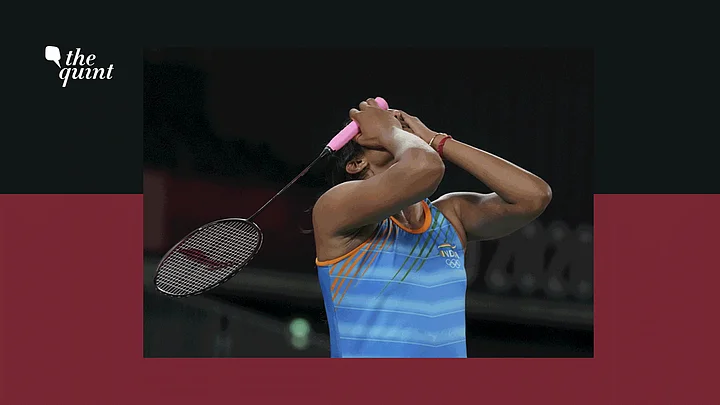She is only 26, a legend of Indian sport even as she continues to relentlessly add pages into an already epic story of greatness. Since breaking through as a teenager, PV Sindhu has consistently saved her best for big stages of her sport. And delivered, with relentless certainty.
We haven’t seen anything like it in Indian sport. On Sunday, she mined a bronze, her second medal in the Olympics, to add another celebrated chapter to her grand legacy.
Sindhu is now the only Indian woman to medal twice at the Olympics. Add the five pieces of metal she has won at the World Championships and you have a career that is truly unparalleled in Indian sport, independent of gender.
It seems as though Sindhu has already spent an entire life working out ways to stitch together a seamless garment of greatness. And it is worn best with the tricolour on her shoulders.
The world No. 6 did just that with a consummate performance against He Bingjiao, the left-handed virtuoso from China.
Sindhu did brilliantly well, just a day after enduring a disappointing loss against her nemesis Tai Tzu Ying in the semi-final. In her second straight appearance at the deep end of an Olympics, Sindhu was outplayed by an opponent with a mystical game at the peak of her powers. It must have been disappointing.
But it is a tribute to the mindset of Sindhu and the team around her, that they were able to set aside their pain and hurt to come back with a robust plan to outplay Bingjiao. It was yet another display of tactical nous and on court tenacity that have been the hallmark of a prolific career full of top draw accomplishments.
Her career is a template, building a legacy, one Lego block at a time. It does not matter that she hasn’t won a single BWF event over the past two years, with the exception of course of the World Championship in 2019. Since then, her eyes have been firmly on Tokyo, preparing body and mind for an assault on an Olympic Gold.
“I didn't know whether to be sad that I have chance to play final or be happy that I have another chance,” admitted Sindhu. “But I am very happy now with this medal and very proud.” So, she should be.
Since breaking through as a precociously talented 15-year-old, Sindhu has worked inch by inch toward establishing herself as the prima donna of Indian sport. It is a great tribute to the coaching school of Pullela Gopichand and the inspiration afforded by the breakthrough achievements of Saina Nehwal, that fuelled Sindhu’s career into an orbit of her own.
Sindhu hovers over Indian sport like an incomparable giant circling alone with a consistency that she has never allowed to diminish. Her definition of consistency though hasn’t been characterised by relentless victory. It has been a journey punctuated by success, saving her best to the most demanding stages in her sport.
A silver (2016) and this bronze (2021) in the Olympics. A gold (2019), two silver (2017, 2018) and two bronze (2013, 2014) in the World Championships. An Asian Games silver (2018). A silver (2018) and bronze (2014) in the Commonwealth Games.
That is a museum’s worth of medals and more. She is a walking hall of famer, only halfway through her storied career. Only time will tell us how many more glorious stories she has on her big game script.
Her rivals on those big medal occasions have been the biggest stars in badminton. Carolina Marin – at the Olympics and twice in the World Championships. Tai Tzu Ying at the Asian Games. Nozomi Okuhara, twice in the World Championships. He Bingjiao in the Olympics on Sunday and Ratchanok Intanon in the World Championships, all the way back in 2013. She was just 18 at the time.
As she built her legacy one brick at a time, she endured plenty of stick. At times it was for her steady stream of losses in the lesser category events. At others, it was for losing in the finals or just a step short of that.
Some critics have called her Silver Sindhu till she silenced them with an emphatic victory against Nozomi Okuhara in the 2018 World Tour Finals. The 2019 World Championships, including a come from behind win against Tai Tzu Ying and a sensational seven and seven thumping of Okuhara in the final was further emphasis of her growing stature as a contemporary legend.
Sindhu has done a great job shutting those voices out, working in increments adapting to the dynamic challenges of a sport evolving a frenetic pace. She has put in an enormous effort working with Park Tae Sang, strengthening her defence and adding guile to an already impressive body of tools.
Sindhu has also put in plenty of work on her body to enable her gain the flexion needed to bend low at the net, before shuffling to the far corner and stretching her back in the opposite direction to keep her opponents honest and under check. Her expanded body of tools came in handy against Bingjiao, as Sindhu shut out her opponent at the net before thumping her into submission from the back of the court.
Now a lot of them will be crying in glee for a bronze statue of greatness to an athlete that has shown up for Indian sport on the biggest stages in international sport.
(Anand Datla is a sports writer and a social worker with over two decades of experience in narrating tales of valour and vain efforts from around the world. He has attended and reported from international sporting events in badminton, cricket, golf and tennis.)
(At The Quint, we question everything. Play an active role in shaping our journalism by becoming a member today.)
